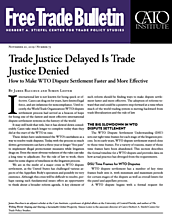1 World Trade Organization, “Understanding on Rules and Procedures Governing the Settlement of Disputes,” art. 4.7, April 15, 1994, Agreement Establishing the World Trade Organization, Annex 2, https://www.wto.org/english/tratop_e/dispu_e/dsu_e.htm#top. “If the consultations fail to settle a dispute within 60 days after the date of receipt of the request for consultations, the complaining party may request the establishment of a panel.”
2 WTO, “Understanding,” art. 6.1. “[A] panel shall be established at the latest at the DSB meeting following that at which the request first appears as an item on the DSB’s agenda, unless at that meeting the DSB decides by consensus not to establish a panel.”
3 WTO, “Understanding,” art. 8.7. “If there is no agreement on the panelists within 20 days after the date of the establishment of a panel, at the request of either party, the Director-General, in consultation with the Chairman of the DSB and the Chairman of the relevant Council or Committee, shall determine the composition of the panel by appointing the panelists whom the Director-General considers most appropriate in accordance with any relevant special or additional rules or procedures of the covered agreement or covered agreements which are at issue in the dispute, after consulting with the parties to the dispute. The Chairman of the DSB shall inform the Members of the composition of the panel thus formed no later than 10 days after the date the Chairman receives such a request.”
4 WTO, “Understanding,” art. 15. “Within a period of time set by the panel, a party may submit a written request for the panel to review precise aspects of the interim report prior to circulation of the final report to the Members.”
5 WTO, “Understanding,” art. 16.4. “Within 60 days after the date of circulation of a panel report to the Members, the report shall be adopted at a DSB meeting unless a party to the dispute formally notifies the DSB of its decision to appeal or the DSB decides by consensus not to adopt the report.”
6 WTO, “Understanding,” art. 17.14. “An Appellate Body report shall be adopted by the DSB and unconditionally accepted by the parties to the dispute unless the DSB decides by consensus not to adopt the Appellate Body report within 30 days following its circulation to the Members.”
7 “Timing of Establishment, Composition, Issuance and Circulation of WTO Panel Reports,” WorldTradeLaw.net.
8 “Timing of Establishment,” WorldTradeLaw.net.
9 “Timing of Appeal, Circulation and Adoption of Appellate Body Reports,” WorldTradeLaw.net.
10 “Timing of Establishment,” WorldTradeLaw.net.
11 WTO, “Understanding,” art. 8.1. “Panels shall be composed of well-qualified governmental and/or non-governmental individuals, including persons who have served on or presented a case to a panel, served as a representative of a Member or of a contracting party to GATT 1947 or as a representative to the Council or Committee of any covered agreement or its predecessor agreement, or in the Secretariat, taught or published on international trade law or policy, or served as a senior trade policy official of a Member.”
12 “Average Implementation Time Periods (in months),” WorldTradeLaw.net.
13 “Timing of Establishment,” WorldTradeLaw.net.



